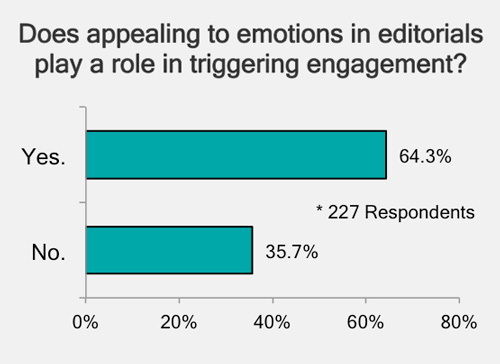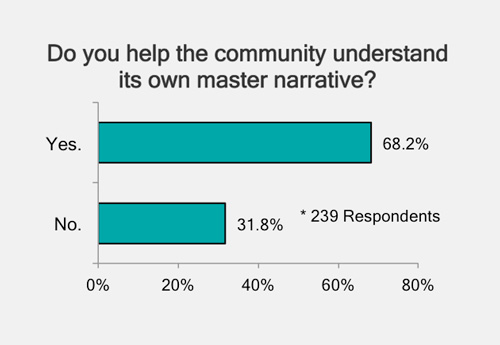The survey queried whether the news sites employed three specific content strategies for engaging their audience. They were asked whether their news site:
- Appealed to emotions in their content or outreach.
- Focused on helping the community understand or address its master narrative – the story it tells itself.
- Engaged in mapping the assets of their communities.
 Appealing to Emotions
Appealing to Emotions
Just over 64% of 227 responding said they found that appealing to emotions in their coverage – frustration, anger, outrage or happiness – played a role in triggering engagement, and 95 respondents elaborated more in open-ended responses.
“People can get frustrated on community issues,” said one. “And we can give them a platform to voice their concerns.”
“Readers are more likely to engage when emotional,” said another. Numerous respondents said emotions particularly stirred engagement on social media.
“Our lurker readers provide a lot of hits to our unemotional coverage, but our commenting community is more active in emotionally appealing pieces,” said one respondent. “Frustration, anger and outrage frequently prompt sharing, commenting and discussion,” said another.
While many respondents embraced an appeal to emotion, others steered clear out of a concern for “journalistic integrity,” they said.
“We absolutely do not do this in our content because we purposefully have no editorial voice or positions,” said one respondent. “However, our social media is a different story. And I’ve found that digging out the nugget in a story that hits people on an emotional level has been extremely successful in engaging readers in our content.”
Master Narratives
Asked whether their news site made it a priority to help the community understand, or change, its master narrative, more than 68% of 239 responding said they did – although they don’t necessarily anchor their coverage in that ongoing narrative.
Master narratives are the overarching or meta-stories that are built from a lot of other “little stories” about a person, place or an issue. When the sum of these stories embody longstanding beliefs about how things work, they become conventional wisdom.
Examples of master narratives include the Rust Belt saga of deindustrialization in the Northeast and Midwest United States, or voter characteristics in Red States and Blue States. The depiction of Silicon Valley as a tech entrepreneurs’ paradise is a local master narrative.
When a master narrative rings true, it engages community members who find it to be authentic. However, when a new narrative is emerging – for instance, a downtrodden community that is starting to gentrify – audiences often experience it before journalists report it.
Grassroots news sites with close community connections have a unique opportunity to engage new audiences by being the first to understand and articulate any new narratives that are taking hold in their communities.
 For instance, several respondents work to counter stereotypes about their community. Some focus on protecting a valued natural resource such as a river basin or lake. Others see a narrative of empowerment, helping people participate in community issues.
For instance, several respondents work to counter stereotypes about their community. Some focus on protecting a valued natural resource such as a river basin or lake. Others see a narrative of empowerment, helping people participate in community issues.
“We don’t have an ‘ongoing master narrative,’ but we do try to speak out against incorrect narratives, both within and outside our community,” said one respondent. “A city of immigrants that is constantly shedding its skins has to stay true to the ‘master narrative,’” said another.
“We share the … irritation that the external narrative is that [our city] is a backwater, that it’s been passed over, that its residents are criminals,” said one.
“People are beginning to see the need for an alternative narrative beyond the cops reports in the local paper,” one said. “We identify the master narrative as a quest for better health-care access, affordability and care,” said one health news site. “By informing readers of efforts to achieve this, it sparks debate on all sides.”
“Our master narrative is that we live in a good community, no matter what you read in the newspaper,” said one. “A master narrative works when it rings true.”
Asset Mapping
One approach holds that digital news sites can engage their communities by validating or cataloguing various community resources, attributes or “assets.” The Knight Foundation has even encouraged people in communities to engage in scavenger hunts to find such information online.
However, only 29% of the survey’s respondents said they engaged in mapping their community’s assets. “We should,” said one respondent. “People take things for granted,” said another. This is an “admirable goal,” said one respondent. “We need help with this.”
Some were puzzled by the question. “I have no idea what you mean by asset mapping. Would love to learn more,” one said. Another pushed back: “Actually, no. We’re not the Chamber of Commerce.”
Many of the survey’s respondents are as interested in building community as they are in covering it. By cataloging or actually mapping community “assets,” or community strengths, some social scientists assert that communities can be empowered to address their problems with local talent and capacity.
A community asset or resource is anything that improves the quality of life in that particular community. Assets can include such things as local experts; artistic or cultural resources; businesses that support the local economy; public, private and nonprofit institutions; associations of citizens; important buildings; sources of funding or natural resources. They will vary from place to place.
When people in a community know who to go to for what, for instance, they are operating with a mental “asset map,” although they might not use that term. News organizations that chart these assets have a more direct path to audience engagement, as they are creating internal structures to support smarter community involvement.
One way many news sites can engage their community in solving problems is by making hidden assets, or strengths, more public.
The news sites that engaged in asset-mapping used such things as directories, resource listings, Google maps, tag clouds or top-picks lists.
Examples ranged from a list of all youth groups that deal in violence prevention to a chart of the connections among members of the school governing board as well as maps of local farmer’s markets, best art shows of the month, searchable databases of health information, a map of one library’s system of capital projects. “We launched a reader survey in the fourth quarter of 2011 asking what makes this area special to our readers,” said one.
“Last year, we gave our community art calendar its own website, along with a directory of artists/ arts, a blog and searchability, and we publicize the calendar as a big resource,” said another.
One arts site rued the fact that it had the “best mapped and curated arts lists ever but ‘we had to let it go.’ In a sense, though, nearly everything we write is in some sense asset mapping of what’s good in [our city’s] contemporary art.”
Others map information to help foster conversations. “Our project to map the residential location of every person elected mayor or council member from 1971 through 2011 showed a gross disparity in geographic representation,” said one.
“This was a major project that’s being used extensively now as the city works toward changing the election system from all at-large elections to council districts.”






